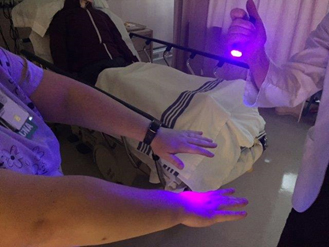Roseburg staff uses simulation to reinforce patient care
By Amanda Morrow BSN, RN and Dixie Fowler RN, CMSRN, CNOR, CPAN
Staff Education Consultants and Simulation Instructors
Roseburg VA Medical Center
ROSEBURG, Ore. – Mannequin and role-play simulation were recently used to reinforce isolation and infection control practices for 68 staff in the Roseburg VA Medical Center (VAMC) Community Living Center (CLC). Participants involved included nursing, social services and rehabilitation staff.
The scene was set with a product called GlitterBug© on the blanket covering the mannequin. GlitterBug© is a hand lotion or powder with an ultraviolet, fluorescent glow. The product is applied to the scene, and then the staff member can be screened for residual glow particles after removing their personal protective equipment and washing their hands.
Before the training, staff members were given an initial briefing about the enhanced barrier precautions policy, as well as a peer-to-peer observation tool used to evaluate compliance with required handwashing and isolation practices.
During the simulations, staff demonstrated handwashing, as well as donning and doffing of personal protective equipment (PPE) while providing care to a high-fidelity mannequin. Staff completed the simulation in pairs, taking turns acting as the care provider or the observer. The care provider was instructed to answer a request for assistance from the mannequin and proceed as they normally would in an isolation room. Participants were then given opportunities for questions during the simulation and in the final debrief, but simulation staff often paused the exercises to address when correct and incorrect techniques were displayed.
At the end of the simulation scenario staff members that provided care were observed using a black light for evidence of the GlitterBug© on their hands or uniforms. This provided trainers the opportunity to identify correct any issues discovered during debriefing.
According to trainers, staff provided positive feedback about the training. “A great course! This really hits home the idea of how careful we have to be,” said one participant.

In the photo, staff inspect hands and personal protective equipment for signs of "glitter bug," which would signify contamination and need for better washing. (VA photo by Amanda Morrow)



















